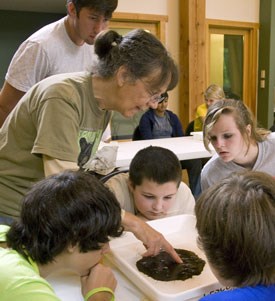
Photo copyright Kevin FitzPatrick. It all started in 1998. That year, the Great Smoky Mountains National Park, along with Friends of the Smokies, the Great Smoky Mountains Association, many local, regional and nationally well-known scientists, and other interested parties came together with a new, exiting idea: to discover every living thing in the Smoky Mountains. To do this, they created a new non-profit partner: Discover Life in America (DLIA), whose goal was—and is—to bring researchers to the park to search for life in forests, soils, caves, and every other habitat in these mountains. The collective effort to do so is called the All Taxa Biodiversity Inventory, or ATBI. Since 1998, Discover Life in America has organized searches for life with public volunteers, university researchers, and amateur specialists. They have funded dozens of research projects and hosted thousands of visitors who worked side by side with scientists sifting through soil for millipedes, wading upriver to collect tardigrades, and crouching in a sun-dappled forest peering at ferns, among other projects. Although their numbers are small, DLIA staff, including Executive Director Todd Witcher, and Database Technician Chuck Cooper, organize scientific explorations and events each year. 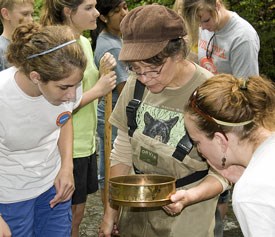
Photo copyright Kevin FitzPatrick. What have scientists in the Smokies discovered? As of October, 2015, through years of work and with the help of thousands of people, we had discovered 8095 species that no one had found before in the park, and 951 species new to science entirely. 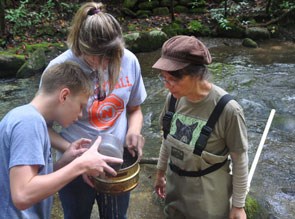
NPS photo. What's it like to search for new species? The day is chilly, and the water chillier, but this doesn’t stop Dr. Andrea Radwell and a volunteer group of local high school students from wading right into Fighting Creek Gap, a shallow, clear stream that runs behind the visitor center near Gatlinburg, TN. Their goal: capture the tiny water mites that thrive in the sandy sediment under their boots. Dr. Radwell is a researcher from the University of Arkansas, and she knows all about the process of catching a water mite, which, it turns out, is very different from catching the bear or trout people picture when they think about Smokies wildlife. Water mites are tiny, round-bodied creatures with eight legs. Some are tenacious predators, while others are placid leaf-litter munchers. All of them live on stream bottoms, so to find them the research team has to scuff and shuffle on the stream’s pebbly bottom, then try to funnel all of the floating debris into a net. Dr. Radwell helps students pour the contents of their nets through very fine mesh filters, keeping just the tiny animals and particles of sand, silt, and soil. The teams do this over and over along different sections of the stream, till Dr. Radwell’s collection jars are full of water that looks like silty chamomile tea, and the teams’ toes are numb. 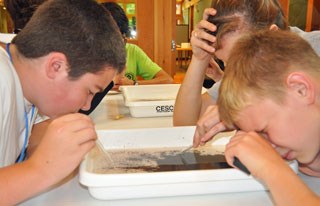
NPS photo. Back at the lab, the teams pour the jar contents out into white tubs and search for the telltale, wobbly swimming of the round water mites. The mites aren’t microscopic, but they are small—about the size of the period at the end of this sentence. Once Dr. Radwell helps the students find a couple, there are cries of “Here! There! Catch that one!” around the room as more floating dots pop into view. The students use pipettes to carefully transfer the mites to the clear surface of a microscope slide, and when Dr. Radwell carries each dish to the microscope, bright blobs of color dart across the projection screen. 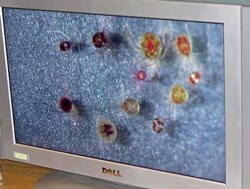
Photo by Dr. Andrea Radwell. There are an estimated 150 different water mite species in the Smokies, and unlike many kinds of wildlife, which only come in brown or black, these mites are bright red, neon pink, lemon yellow, grass green, and smoky purple. Each bright colored dot is a different species that fills a specific ecological niche, or place, in the Smoky Mountains. In Dr. Radwell’s most recent searches through Smokies streams, she’s found two new species of water mites to add to her impressive list of mite discoveries. When she and other scientists discover new species, they get to name them (often with something like Appalachia or Smoky Mountain in the name) and publish a description in a scientific journal. The documentation becomes part of the ongoing list of All Taxa in the Great Smoky Mountains, and inspires new searches for life and new studies about the diversity within these protected boundaries. 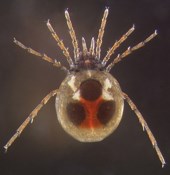
Photo by Dr. Andrea Radwell. Dr. Radwell passed away in 2015 and is sorely missed. More information about Dr. Radwell's work and more images of watermites from the Smokies can be found at her University of Arkansas web page.
For those still in school...how you can discover life 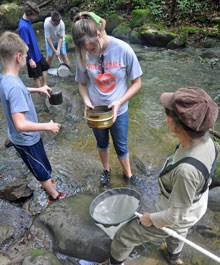
NPS photo. Are you interested in searching for new forms of life? If you like spending your days in the field with a net, a guidebook, and a magnifying glass, here are some ways you can do that in our National Parks: In high school: Take biology, geography, chemistry, earth science, geology, ecology, and math courses geared for college-bound students, because these will prepare you for challenging college courses. Ask parks if they have high school summer internships, as the Great Smoky Mountains National Park does. You can also gain valuable experience as a summer or after-school volunteer. Some internships at the high school level allow you to gain experience in observing, collecting, and identifying different forms of life. You need at least a high school diploma or GED for most seasonal jobs, and you should plan on getting a bachelor's degree to continue in the field. In college and/or graduate school: As with many careers in the national parks, a B.A. or B.S. in a related field (biology, botany, entomology, geography, ecology, chemistry, geology) helps you find opportunities and know what you're doing. A master’s degree and independent research in these specialized subjects are helpful if you want to be an expert in the field. Many who work with the park service’s Inventory and Monitoring program have specialized degrees based on the study of certain organisms, such as plants (botany), insects and other invertebrates (entomology), or microscopic organisms (microbiology, for one). Some people also have more general degrees that look at how these individual parts fit together in the landscape as a whole: geographers and landscape ecologists look at trends over the landscape. Essential to all of these positions is an interest in taxonomy: knowing how to identify what you find in the field. If you're fascinated by the health of individual creatures or how a complicated ecoystem works, a career inventorying and monitoring their health may be for you. Gaining other experience: Showing that you are interested in not only the excitement of field discovery but also the detailed, long-term identification of what you find is vital. You can gain experience for a career through internships and seasonal jobs. Also, check out the Federal Jobs website for current, competitive job openings: search for the biotech positions that have your level of education as a qualification. You may not start out working directly doing inventory and monitoring, but jobs that familiarize you with catching and identifying different forms of life--fish, insects, plants, etc--will help you gain experience. These jobs may also help you gain entry level jobs or a spot in a college, Master’s, or PhD program. Good luck, and have fun! Return to Inventory and Monitoring main page, or return to Nature main page. |
Last updated: November 10, 2015
